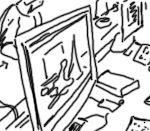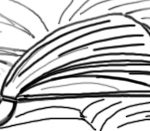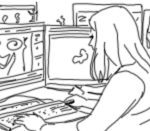What does it take to get your foot in the door and land that first animation job?
It takes perseverance and a good demo reel to get your animation career started. It really does not matter what degree you have. Your work needs to look like the kind of work you are being hired to do. Your resume and the way you present yourself need to assure your potential employer you are reliable and easy to work with.
What are your chances of being successful in your animation career?
A friend in the industry once said, when asked by a group of student “What chance to do you have of getting into the industry? 100% if you are good.” There is also some luck involved with which companies you work at and when, but in general it is pretty true. You make your own luck by being prepared when the opportunity arises. Focus on getting good at your passion (animation, design, modeling, gaming, VFX, etc.) Don’t compare yourself to someone in your school or class. What’s important is your demo reel holds up to other professionals working in the industry to start your animation career.
You need to be brutally honest with yourself about your strengths and weaknesses. What are you really good at? It takes time to become really good at anything you do. You don’t have to be an expert when you start out but you should, however, have an aptitude for the skills you are developing. Show your work to your teachers, colleagues or pros in your field. With social media and conventions like CTN Expo, SIGGRAPH there are many opportunities to seek out critiques and advice.
How do you know what you want to do?
Start now. If you think you want to be a director, give yourself an assignment. Make a short. If you want to be a character animator, download a free rig and animate test scenes. Start with small manageable projects. There are a lot of resources online to help you learn and get started. We list a bunch here. If you need software, check out this site. Some tools are offered for free or at a discount if you are a student. This way, you will learn what you really like to do and what you don’t like to do. You might surprise yourself. Do you have the passion and skills to do what it takes to pursue your focus in your animation career? Find out by doing it. Don’t wait for someone else to give you permission to pursue your career. Start today.
Should you go to school to get an animation career?
We both got our masters degree at USC film school, so we have a bias for education. That said there is a lot of benefit from going to a four year university.
“You are learning about much more than just animation. I still think about and use things that I have learned in my undergraduate philosophy and English writing classes every day. Community colleges can be a great way to concentrate on animation or transition to a four year institution. Many community colleges offer specialized class that might not be available in a four year school. I took community college classes while I was an undergrad because they had a good animation program. Community colleges can be a great option.” – Mark
On-line schools are great at area focused education, but are not a substitute for a general liberal arts education. IAnimate, AnimationMentor, FXphd, etc. are good at teaching character animation and visual effects specifically. You might look at them as additional resources to a traditional liberal arts education. See the list of schools here.
How do you pick a school?
Look at the student work and the faculty teaching the program. These are some of the best indicators about the school you are looking at. Every program is different and this will help you assess if a program is a good fit for what you want to do with your animation career.
 Do you want to be a character animator? Here are some resources for you
Do you want to be a character animator? Here are some resources for you
We own all the books shown in the book section and we want to mention our top picks. We would recommend starting with a book by Eric Goldberg called “Character Animation Crash Course!” It comes with a DVD that shows you the animation, described in the book, coming to live. Eric is the genius animator/director who brought Genie from “Aladdin,” Phil from “Hercules,” Louis from “The Princess and the Frog,” and more to live. In his book, he writes about acting in animation, character construction and design, layout and staging, timing, spacing, breakdown, squash and stretch, overlapping action, weight, balance, mass and volume, properties of matter, facial expressions, lip-sync, and more. He gives a great foundation and concept behind creating a fluid style animation. Richard Williams’s “Animator’s Survival Kit” is another good book to have. It explains all the technique of animation from a walk, run, sneak, jump, skip, and more. All the Muybridge books are well worth the investment. If we have to pick one, get the Complete Human and Animal Locomotion, Vol, 1, 2 & 3. We keep on going back to them even now for movement reference.
“I was introduced to Desmond Morris’s ‘Manwatching’ by Glen Keane at a Disney lunch box lecture. Glen is another genius animator who brought Tarzan, Pocahontas, Ariel, Beast and many more amazing characters to life. ‘Manwatching’ is a good study of human social behavior. It talks about human actions, postures, gestures, facial expressions and more. Glen has taught us to have sincerity in animation. Understanding human behavior is one of the key elements in creating sincere animation.” – Yuri
Also take a look at our reference page. There are a lot of free tutorials in animation you can take advantage of.
If you want to learn about story, check out these books
Blake Snyder’s “Save The Cat!” and “Save The Cat Goes To The Movies” are invaluable. He breaks down story in a way that is easy to understand. Our USC Film School teacher Bruce Block’s “The Visual Story” is a must read. It helps you understand visual film language and how to use them to tell a story effectively and dynamically.
If you are interested in becoming a director, this is a great book to get you started in the path
Tony Bancroft’s “Directing for Animation” gives you a good insight in what it is like to direct an animated movie.
If you want to be a lighter, these books are great
Jeremy Birn’s “Digital Lighting & Rendering” is considered one of the best books on CG lighting. Johannes Itten’s “The Art of Color” is a good read. We have the “Art and design books” section for art and design inspiration.
For modelers, animators and riggers, knowledge of anatomy, skeleton and muscles is helpful
“Stop Staring: Facial Modeling and Animation Done Right” by Jason Osipa is an excellent resource for modelers. “Facial Expression” by Gary Faigin is a good book to learn the muscle movement associated with emotion which is also a necessity for modelers, animators and riggers. “Skeleton” by Steve Parker is great to learn the structure beneath the body for modelers, animators and riggers.
Having a strong camera knowledge is essential for previsualization, layout and cinematography
“The Five C’s of Cinematography” by Joseph V. Mascelli talks about camera framing and movement to tell a story. It’s a good book for learning about previsualization, layout, cinematography which is a skill all filmmaker needs to have.
You might be wondering why we have a “Favorite Comic Books” section
It’s because comic strips illustrate strong poses, staging, expressions to tell a story. That’s essential in animation. We can learn so much about animation from them. “Calvin and Hobbes” is a great animation reference. It’s worth the investment getting “The Complete Calvin and Hobbes” by Bill Waterson. We enjoy reading them over and over again.
We listed some of our favorite movies in the “Movie” section
Hope you’ll enjoy them.
Okay, let’s start building a demo reel today
It will help you see what you have and what you’ll need to add to improve your reel. Get started with free website tools such as weebly, wix and sites.google. These are great tools to make a good looking portfolio. Go to “Demo Reels Advice” for more detailed advice on how to make a demo reel.
Now it’s time to apply for an internship and get your animation career started
Click on “Job Listing Sites.” If you create an account on one of these sites, you can get an alert letting you know what opportunity there are each week. You can also go to “Career” for specific studios’ career listing. In order to get an internship, we recommend preparing a cover letter and resume. Go to “Cover Letter Advice” and “Resume Advice.” A recommendation from your teachers is always a plus.
You may want to consider submitting your film to festivals and conventions. Who knows your film may even win or be nominated for an Oscar.
Once you land on an internship, put your best effort forward no matter how small the task seems. Spend some time getting to know the people you work with. Be a teamplayer, make a good impression and appreciate the opportunity. Sometimes, an internship can transition into a full-time job. The experience and skills you earn and the connection you make will get you the next job.
 Are you ready to work full-time?
Are you ready to work full-time?
A studio like Disney, Dreamworks, Warner Bros. are a union shop which means that if you are an artist you’ll be joining an union and your wages and benefits are laid out by the union contract. You can check the “going rates” for Guild members employed in various job categories for your wage negotiation. For example, here is the 2016 wage survey result You can also go to a job listing site like simplyhired.com or Glassdoor.com to find out the going rates.
“A few things I didn’t know when I accepted my first union job is the union initiation fee can be hefty and the health insurance doesn’t kick in until you accumulate enough hours. So be sure to ask for help when you negotiate your salary and benefit.” – Yuri
If you want more information about how animation union works, go to “Animation Guild.” A studio like Pixar and Blue Sky is a non-union shop. The company sets the rules with wages and benefits. You’ll need to find out by asking them.
Is freelance the way to go?
Freelance can be an excellent way to start out and can be a good lifestyle for some artist. Depending on what you do you can get paid more as a freelancer. The downside is freelancers usually don’t get benefits. It is advisable to include the cost of health insurance and other expenses into your wage if there’s room for negotiation. The advantage of being a freelancer is the flexibility and control. You are your own boss. If you like hustling for jobs and working in many different projects, this may be the animation career path for you. You can set your own terms which means that you might be able to work from home. If you set yourself up as an S-corp, you might be able to save on your taxes. We would recommend talking to your accountant about how this works.
What are the animation industry trends these days?
Most artists, even at a major studios, are project-to-project hires now. Having a long-term job contract is rare these days. Layoffs are common when a project winds down. Be prepared. We recommend saving money and prepare for the rainy days, because it can happen to anyone over the course of their animation career. The only thing that is predictable is “change.” Sometimes the advancement of technology pushes one form of art into another. For example, in the 90’s 2D animation transitioned to 3D animation. A lot of 2D animators had to either transition to 3D animation, move onto character design/story, or face layoff.
The business model has changed over time. Outsourcing has become popular to save money on productions and maximize profits. Dreamworks and Paramount outsource some of their projects abroad. The business model of production starting from layout/animation being done outside of the U.S. has been a part of animation since the 1970s. Direction, art direction, visual development, character design, some previs, some modeling are done locally to have the creative control. The good news is the industry is growing so the number of jobs in the United States is also growing. These days, China and India’s film industry have become stronger. We are seeing some Indian and Chinese companies popping up in L.A. For example, Rhythm & Hues and Crest Animation are now Indian companies. Original Force is a Chinese studio based in L.A. Some more are starting up.
Game Animation and Game Design are an excellent options to pursue as a career. Artists commonly move between game, app, television and feature animation projects. The video game industry is a robust and fast growing part of our economy. Last year the U. S. video game industry earned an estimated $30.4 billion in revenue. Animation and game positions have expanding demand for highly compensated positions.
Last words of advice for your animation career
The animation industry is a relatively small community and helping each other will get you far. Someone’s success will become your success and vice versa. One studio’s movie success is good for other studios. It vitalizes the animation industry creating more jobs. Our teacher, director and ex-President of the Animation Guild, Tom Sito, told us “Experience first, reputation second and then money.” When you start out, focus on building your experience. You will earn your reputation through great work. Then you will be paid well. It’s the way it goes with everything, isn’t it? We hope that AnimationMojo will help you succeed in your adventure. Best of luck with your animation career.





 Do you want to be a character animator? Here are some resources for you
Do you want to be a character animator? Here are some resources for you
 Are you ready to work full-time?
Are you ready to work full-time? 